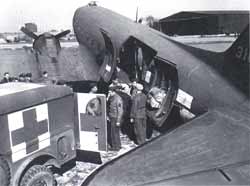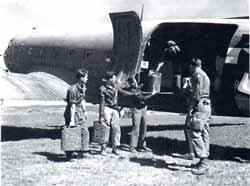|
by George "Pete" Buckley, 74th TCS In the closing days of the
war in Europe, in April 1945, troop carrier planes flew a total
of 16,387 sorties, many of them in the face of enemy flak and
small arms fire. By April 20, Troop Carrier Command had used
240 airfields from Cherborg to Leipsig for these sorties.
In this same time span, IX Troop Carrier planes during the campaign inside Germany delivered 44,212,200 pounds of freight and 7,727,075 gallons of gasoline to our rapidly moving ground forces. On April 4th alone, they delivered to the front more tonnage in a single day than the entire tonnage for the first three months of 1945. From airstrips all over Germany they flew 45,000 American, British, French, Russian, Polish, and Italian released prisoners of war back from the areas of their captivity in Germany. This was truly a monumental effort on the part of the IX Troop Carrier Command and its supporting ground units, surpassing at this point in time the activities of the Eighth and Ninth Air Forces. On the 9th of April, one of troop carrier's smoothest operations of the war was demonstrated in and around the town of Crailsheim, in Germany. A U.S. armored spearhead of the 10th Armored Division had advanced so far and so fast, that they were pinched off and surrounded by a far from beaten, still deadly and dangerous enemy. Short on food, gasoline, and ammunition, they sent out an urgent S.O.S. for aid. Twenty-two supply trucks from VI Corps that attempted to break through to them were destroyed by a determined and desperate enemy intent on wiping out this pocket. When VI Corps was informed of the failure, they realized that troop carrier planes were the only answer to the problem. Thirty-four C-47s of the 441st Group took off from Dreux, France, flew through heavy enemy flak and small arms fire, and landed on an airstrip at Crailsheim. While the enemy was subjecting the field to heavy mortar, Nebelwerfer, and shell fire, as well as infantry attack only 1,500 yards away, the air crews and the armored personnel trapped there unloaded 160,000 pounds of gasoline, 37,865 pounds of ammunition, and 5,400 pounds of K-Rations from the planes. One plane was destroyed on the ground with one crewman a casualty. The other 33 planes after unloading, took off with 42 wounded men aboard and arrived back at Dreux at 2200 hours. Four aircraft limped back with major damage from enemy fire.
On the following day, April 10th, an additional sixteen C-47s flew in to Crailsheim and delivered 31,000 pounds of .50 caliber ammo, 31,590 pounds of 105 mm shells, and 21,600 pounds of rations. All planes returned safely by 1000 hours. On both of these operations the C-47s had top cover support from fighters of the Ninth and Eighth Air Forces. As a direct result of this troop carrier effort by the 441st Group, the beleaguered armored unit at Crailsheim was able to fight it's way out of this pocket, bringing with them over 2,000 prisoners, and linked up with the main body of American forces. Lt. General Patch, commander of the Seventh Army, and Major General Edward Brooks, commander of VI Corps, commended IX Troop Carrier Command on the magnificent and courageous efforts by the crews of the 441st Group, and the fine unit coordination between Troop Carrier Command and Army ground forces involved. In addition to this, troop carrier planes flew six evacuation and medical hospitals to front line battle areas, and resupplied forward combat elements with badly needed equipment, rations, and ammunition. In spite of their month-after-month, seven-day-a-week schedule, they still managed before the war ended, to plan and execute six major airborne operations in the European Theater, involving large scale paratroop and glider landings behind enemy lines. On the major airborne operations in which they participated, these C-47 crews after flying at altitudes under 1,000 feet through heavy enemy flak and small arms fire, towing gliders and carrying paratroopers deep behind lines, had to make the round trip back to base through this same enemy fire at treetop level. Then, until join-up with friendly troops was complete, they had to make this same round trip to resupply the infantry and glider personnel on the ground. Every flight was so low that the enemy could hit them with pistol and rifle fire, in addition to heavy flak weapons. Early in the war their planes had no self-sealing gas tanks, they were unarmed, and they were under strict orders to take no evasive action. Those planes that did catch fire from enemy fire - and there were many - were often too low for the crews to bail out. We glider pilots, who by then had the safety of a foxhole to hide in, agonized at the sight of them coming over on the resupply runs, and held our breath counting the chutes coming out of stricken aircraft, especially if we recognized ones from our own group. We saw planes with wings on fire and engines screaming, struggling to hold altitude and formation until their para-packs were released over the landing or drop zones. They say that glider pilots had it tough, but most of us wouldn't swap places with those C-47 crews for any amount of money. We only made one trip; they made many round trips. Their casualties were often times higher than the glider pilots who were fighting on the ground. In a letter to General Williams, commander of IX Troop Carrier Command, General Carl Spaatz, USSTAF commander stated, "The IX Troop CArrier Command, the staff, the commanders, the flying crews, ground personnel and support units, are to be commended for their noteworthy and important contribution to the successful prosecution of the final phase of the war against Germany". thus ended the hostilities in Europe in early May, 1945. Ernie Pyle, the famous and favorite war correspondent of the GIs in WW II, at one point in the war remarked to a C-47 troop carrier pilot, "This is one of the best airplanes in the world." Most GIs that observed troop carrier planes in action will agree that it indeed was. |

